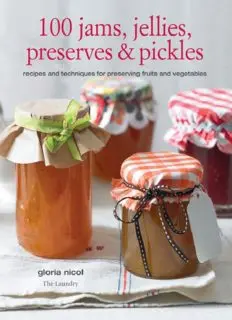
100 jams, jellies, preserves & pickles : recipes and techniques for preserving fruits and vegetables PDF
Preview 100 jams, jellies, preserves & pickles : recipes and techniques for preserving fruits and vegetables
100 jams, jellies, preserves & pickles 100 jams, jellies, preserves & pickles recipes and techniques for preserving fruits and vegetables G L O R I A N I C O L The Laundry contents Why make jam? Choosing your ingredients Preserving equipment Preserving techniques Jams Jellies Marmalades Curds Nectars Fruits in syrup Chutneys Pickles Useful addresses Index why make jam? There is something so satisfying about opening a food cabinet or pantry to find the shelves stacked with colorful jars of homemade preserves. These containers of summer and fall flavors might be just what’s required to lift the mood on a dark, gloomy winter’s day, when a good dollop of strawberry jam on your bread reminds you of longer, warmer, lighter days. For me, that is what making preserves is all about: capturing the essence of whatever fruit or vegetable it is and sealing that flavor in a jar for another day. I started making jam 30 or so years ago and have always enjoyed it, despite my fair share of sticky mistakes. It is a traditional part of homemaking that celebrates the seasons and somehow makes life cozier and more comforting. My preserves are handmade and full of chunky pieces, which sets them apart from anything store-bought. The flavors of the fruits shine through and are rarely masked with spices. Where possible, I reduce the amount of sugar, because the tarter the fruits, the fresher tasting the results. In the current climate of concerns about being less wasteful, clocking up fewer food miles and eating seasonal, locally grown food, making preserves has never been so popular. choosing your ingredients Although strawberries—to give just one example—can now be bought virtually all year round, thanks to the introduction of new varieties, the use of field tunnels, and the massive increase in imported produce, nothing beats the flavor of a homegrown strawberry that has ripened in the sun and been picked only moments before. It is this flavor, so sweet and intense, that can be captured in preserves. Using your own homegrown produce for preserving is hard to beat, because the ingredients will be fresh and you will have control over their growing conditions. Farmers’ markets are another great source. You’ll know that the fruit and vegetables have been grown locally, and you are more likely to find unusual varieties. Whatever its source, rinse produce before use, although ideally not bush fruits since rinsing can reduce their juice content. However, if they may have been sprayed, you will need to rinse and drain them. Food for free Sometimes ingredients are right in front of your nose, and all you have to do is go out there and find them. Woodlands and hedgerows (if you live in a part of the country where these are common) are full of edible fruits and berries if you know what to look for. You may find crab apples growing wild, along with damsons, greengages, or blackberries. Alternatively, if you know someone who grows more fruit than they can use, offer to take it off their hands in exchange for a jar of preserve made using it. It’s a win-win situation. Fruit and pectin For almost all fruit preserves you need to choose fresh, good-quality, just- ripe fruit in order to achieve the correct pectin content. This is because jam needs the right balance of pectin, acid, and sugar to set properly. Different fruits contain varying amounts of pectin, and the pectin content is higher in just-ripe fruit. Fruits high in pectin include crab apples, Seville oranges, just-ripe fruit. Fruits high in pectin include crab apples, Seville oranges, damsons, gooseberries, quinces, and currants. Fruits low in pectin include strawberries, pears, elderberries, fresh apricots, and cherries. Some fruits contain very little pectin, and so jams made using these fruits will need additional help to make them set. Overripe fruit can also lower the pectin content, which is why such fruit is not suitable for jams. It is, however, suitable for nectars, so use any fruit that is too ripe for jam to make a delicious nectar or syrup. The pectin content can be raised in various ways. Mixed-fruit jams can use the higher pectin content of one fruit to offset the lower content of another; lemon juice can be added at a rate of the juice of 1–2 lemons to every 4 pounds of fruit, or bottled pectin can be used. preserving equipment The principle underlying all preserving is to prevent decay caused by the growth of yeasts, molds, and bacteria. These organisms are destroyed when heated to sufficiently high temperatures to sterilize them, and, once sterilized, preserves must be kept securely sealed so that air cannot enter. Preserves that contain 60 percent or more of sugar are less susceptible to the growth of yeasts, which is why jams containing less sugar need to be eaten more quickly. THE JARS The jars normally used for preserving in the United States are called mason jars. They have a screw-on lid consisting of two or more sections to help ensure a tight seal. You may also find European-style canning jars, which have glass tops, secured by a thick wire clamp. Both types come in a range of sizes.
